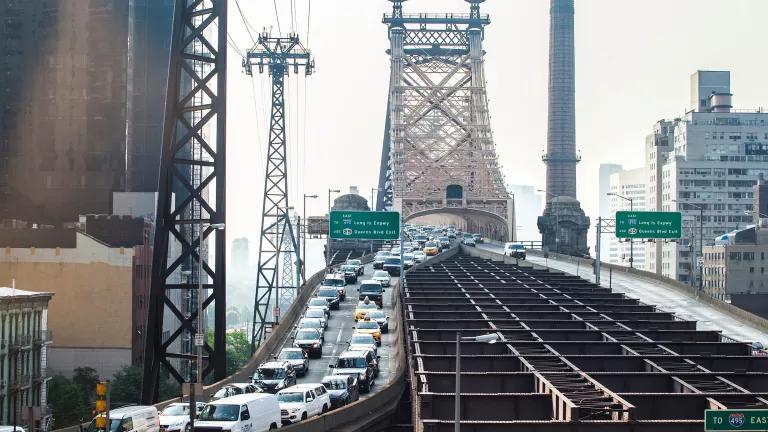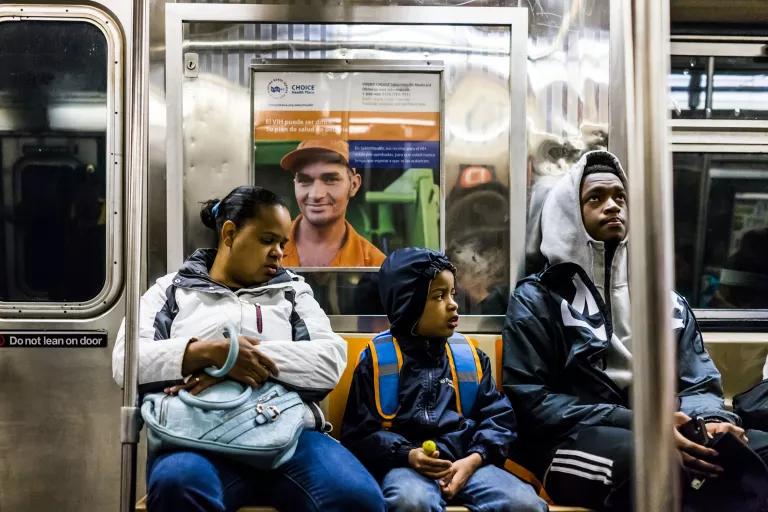What Is Congestion Pricing?
Fees charged for driving on busy city roads reduce greenhouse gas emissions and improve air quality while also generating sorely needed funding for the transit systems that many people rely on for their daily commutes.

A traffic jam on Queensborough Bridge in Manhattan, July 3, 2018
Stefan Ugljevarevic/Shutterstock
A simple solution that can cut traffic and air pollution and get us to work faster may seem pie in the sky. But it’s out there, and it’s gaining traction in cities around the world. Congestion pricing refers to a fee levied on drivers that’s intended to convince enough people to avoid hopping in their car at rush hour. Or, as the U.S. Department of Transportation frames it, it’s “a way of harnessing the power of the market to reduce the waste associated with traffic congestion.” The ultimate goal is to make the transportation system work better for everyone—and clean transportation advocates say it’s most effective when it reinvests the profits gained into local public transit systems and other equitable means of getting around town.
New York City congestion pricing
Congestion pricing proposals tend to inspire hearty debate. That was certainly true for New York City. Decades of discourse preceded the Big Apple’s decision to move forward with its plan, which was followed by two years of delays, courtesy of the Trump administration. While transportation officials in New York have been advocating for similar measures going back to the 1970s, it was former mayor Michael Bloomberg who launched a serious push to impose a user fee on vehicles entering Manhattan’s busiest streets in 2007; the latest plan will have commuters who drive to work paying a fee starting at the end of 2023.
Despite the obstacles to congestion pricing over the years, transportation leaders stuck with it because they believed in their mission. The goal was twofold: unclog the busiest streets, where unchecked car use imposes congestion and air pollution, creates safety hazards, and gums up bus service; and raise a billion dollars a year for New York’s ailing subway, bus, and rail system.
Over the years, some stakeholders raised questions about how congestion pricing could work, not just to reduce traffic but to do so in a fair way. Some asked whether congestion pricing would hurt lower-income city residents. That is simply not the case. We know that people driving into Manhattan at rush hour are overwhelmingly wealthier. After all, a space in a parking lot can set you back more than $30 a day.
“A very, very small portion of drivers who enter Midtown Manhattan during business hours are economically disadvantaged,” says Eric Goldstein, a senior attorney and New York City environment director at NRDC.
In 2017, the Community Service Society (CSS), the city’s leading anti-poverty organization, completed an analysis of who would be impacted by congestion pricing in the Big Apple. It concluded that only 4 percent of working residents of the city’s outer boroughs (that’s jargon for Brooklyn, Queens, the Bronx, and Staten Island) commute to jobs in Manhattan by car. In contrast, 56 percent of outer-borough working residents use public transit to get to work and would benefit from the funds generated by congestion pricing. The CSS study also found that only 2 percent of the city’s working poor would potentially be subject to the congestion fee.
Do you have to pay to enter NYC?
Already, many drivers do pay. For example, anyone who crosses into Manhattan by car, say, via the Robert F. Kennedy Bridge or the Queens-Midtown Tunnel, knows that it’ll cost you a pretty penny.
Under the new congestion pricing scheme, drivers entering the central business district—i.e., Midtown or downtown Manhattan—will have to pay as well, equalizing costs for motor vehicle commuters and reducing traffic and pollution from drivers who would travel miles out of their way just to avoid the existing tolls.
But the new costs (which have yet to be determined) will have little downside for low-income New Yorkers. Census data show that income and car use correlate strongly—especially so in New York. The vast majority of low-income residents use buses, commuter rail, ferries, bicycles, and the subway to get around. And they will benefit directly from the congestion pricing fees, which will support a big chunk of the Metropolitan Transportation Authority’s 2020–2024 capital program to improve services. Funds raised will support additions like replacing broken signals and outdated train cars, among other upgrades, like expanding accessibility for riders.

A family making their morning commute by subway in New York
iStock
Benefits of congestion pricing
Adding buses and reducing subway delays saves commuters time. Many low-income people earn hourly wages, and other workers have to pay for child care or elder care during their prolonged commutes. Saving time means saving money.
In New York, congestion pricing will benefit commuters in other ways too. A mountain of research shows that low-income households, and especially low-income households of color, are concentrated near pollution sources like highways. Asthma, in particular, is a disease of poverty. In the first year of London’s congestion pricing program, reduced traffic decreased nitrogen oxide emissions by 13.5 percent and particulate matter by 15.5 percent. Over time, that positive impact on local air quality has so far added 1,888 years to the lives of Londoners. The benefits have been even more dramatic in Stockholm, where congestion pricing cut hospital visits due to childhood asthma nearly in half.
Other American cities may soon adopt similar plans. Los Angeles, for instance, is considering a comprehensive system to use congestion pricing “go zones” to speed up commutes and improve public transit in the city’s high-traffic areas. L.A.’s policymakers are considering a variety of factors to ensure their plan is progressive, according to NRDC mobility and climate advocate Carter Rubin.
“People driving alone in cars at rush hour toward busy office districts tend to earn higher incomes,” says Rubin. “People who have shift-based jobs, such as in hotels, restaurants, and retail, are traveling less at rush hour and are using public transit and carpooling more. So you can design a system that has a progressive effect based on when [fees are collected] and who has to pay.”
As in New York, many low-income Angelenos currently spend hour upon nonproductive hour in traffic trying to get to their jobs. So even for those who are traveling during rush hour, paying a fee might be worthwhile if it reduces traffic and gets them to their workplaces faster. The revenue generated from congestion pricing creates the possibility of fee discounts for people with low incomes or for those who carpool. And if America’s most car-centric city can embrace it, it will no doubt be an inspiration to transportation planners nationwide.
This NRDC.org story is available for online republication by news media outlets or nonprofits under these conditions: The writer(s) must be credited with a byline; you must note prominently that the story was originally published by NRDC.org and link to the original; the story cannot be edited (beyond simple things such as grammar); you can’t resell the story in any form or grant republishing rights to other outlets; you can’t republish our material wholesale or automatically—you need to select stories individually; you can’t republish the photos or graphics on our site without specific permission; you should drop us a note to let us know when you’ve used one of our stories.

Public Transit Just Helped Save America. Now America Needs to Return the Favor.
Mapping Urban Heat Islands Is Helping These Neighborhoods Adapt
Failing to Meet Our Climate Goals Is Not an Option